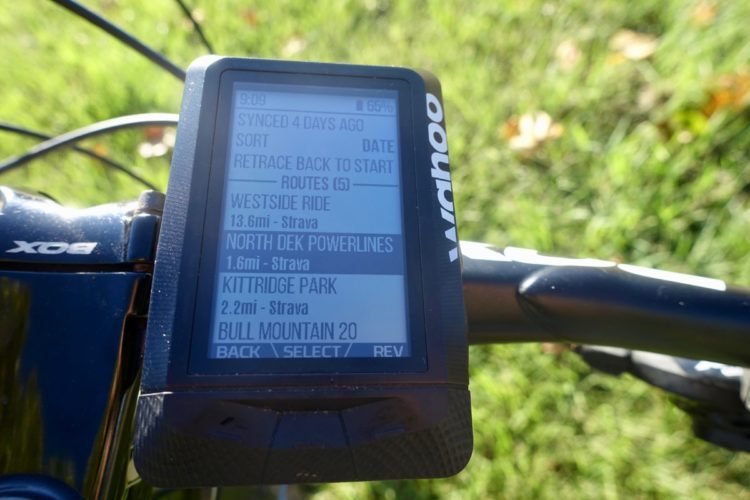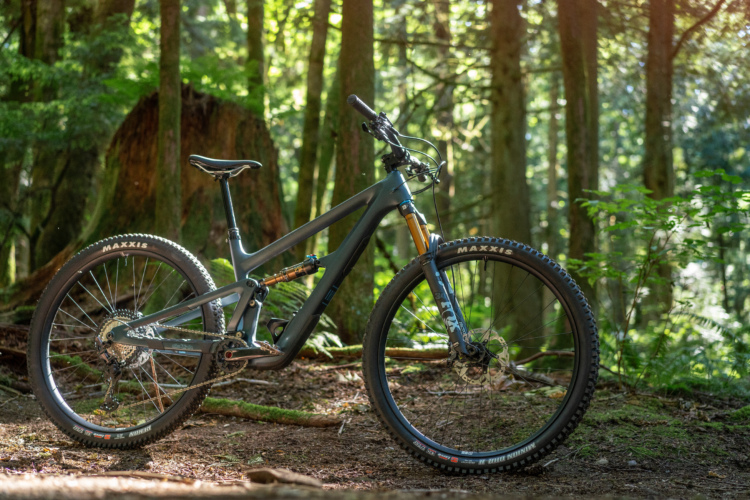
Earlier this year in May, Wahoo Fitness expanded the Elemnt line of GPS bike computers with the Wahoo Roam, which is billed as more mountain bike friendly. The new unit makes it easy to import maps from sources like Singletracks, adds a color display, and integrates new navigation features.
Tracking fitness data can be a divisive topic for some, but there are die-hards who never ride without a computer. Although Wahoo is a relatively new competitor in the arena compared to Garmin and similar brands, the computers have proven themselves with reliability and ease of use.
I received the Wahoo Elemnt Roam in late June, just ahead of the busy summer riding season, and have logged about 800 miles on the unit before writing this review. The battery life hasn’t slowed it down, and neither has weather, data, or dirt.
Specs

- GPS unit setup via Wahoo Companion App
- Wireless connection for map imports and updates
- 2.7″ color display
- Customizable screen display
- USB rechargeable battery
- ANT+ and Bluetooth capability
- Turn-by-turn navigation
- Pre-loaded with N. America, Europe, Asia, Oceania, and S. America maps
- On-demand route generation, and re-trace route
- Saved/favorite locations stored on unit
- LED notifications for navigation, Strava segments, and phone alerts
- Ambient light sensor for auto backlight
- MSRP: $380, available at REI
The Elemnt Roam on and off the bike

The overall design of the Wahoo Roam is pretty simplistic, and that’s a good thing. The last thing most of us want is to be mashing buttons ahead of a ride, trying to figure out which button does what.
On the Roam, the buttons remain in a traditional Wahoo layout, with one on the left side, two on the right, and three on the bottom front. The left button powers the unit on and off, the two on the right are used to magnify in or out of a map or screen, to alter what’s on display, or to work through the menus, and the three on front are used to start or stop a ride and to make selections or move through display pages.
The backside of the computer still uses the twist-lock mount to fix it on a handlebar or stem mount, and the 2.7″ screen is made from shatter- and impact-resistant Gorilla Glass. I used the stem mount for most of my time with it, although on modern mountain bikes with 50mm stems, it only fits on the handlebars.

Setup is straightforward with the Roam and the Wahoo Companion app will guide users through when they pair their smartphone with the Roam. Setup can be as simple or complicated as the user likes. If they just want to get the Roam roaming, then they can power through the setup process to determine which units the Wahoo will measure with, what language is used, and so on.
The Wahoo Elemnt Roam can be paired with several different apps, like Strava, Training Peaks, the Singletracks app, MapMyFitness, and more. This makes the process of exporting ride data to apps like Strava or Training Peaks automatic. Once a mountain biker finishes a route, they open the app, connect to the computer with Bluetooth, and the app will sync the ride and export to a third-party app.
By going into the settings in the companion app, then the Wahoo Roam can be more finely tuned for use. Display pages can be altered for user preferences, although there is a limit to what can be on a page. The main information display is limited to 11 items, and some riders might still want more information. Each page display on the Roam is customizable via the app.

Also within the Companion app, users can look through the stats of each and every ride recorded, pick a workout from the app like a FTP test, or a sprinting session, and edit their profile.
Now, moving to the physical unit. The Roam takes a solid 20-30 seconds to power on, so in the case of lining up at a start line, it’s better to get it going during the warm up. The good thing though, is that once the Wahoo Roam is on and senses that you’re changing location, it will ask if you’d like to start the ride.

I set my Wahoo main information page up with a full 11 display items, to include current speed, total distance, clock, max speed, total feet climbing and descending, the elevation, grade, and battery life. The battery life stat was something I added later after getting caught off guard with a dead Elemnt a few times.
The map page now displays in color, but the color is pared down to one or two shades of blue, which mark favorites, or bodies of water, yellow, which marks roadways, and other favorites from the classic 8-count box of Crayolas. Honestly the limited colors are probably all that’s necessary to make greater distinctions on the map.

Speaking of maps, the routes were fairly painless to import onto the Roam and there are three steps of directions that help the process on the Companion app. First, download a .gpx file to your phone, then on the file, select “open in,” and then select “copy to ELEMNT.” Once the app syncs with the Elemnt, then the route will show up on the GPS unit.
If you create a trail wish list on Singletracks, the app will automatically sync those routes and they will show up on the GPS unit. This is done over a WiFi connection.
Navigation is easy to understand with the route onboard the Wahoo Roam, and if you need to get a wider or more narrow view of the trail direction, just zoom in or out.

If a turn is coming up, the LEDs at the top of the Wahoo Roam will flash to signal the upcoming change. The LEDs can also be programmed to notify a pause or resumption in a ride, upcoming Strava Live segments, and an incoming notification.
I will say that the LEDs aren’t entirely intuitive. Most riders will need to learn what the signals mean, program them specifically, or just ignore them until they learn what the computer is trying to tell them. The vertical lights move up and down the display, seemingly at random, but can tell the rider if she is going slower, maintaining an average speed, or increasing the average speed.
Other notifications like texts and emails are displayed near the bottom of the screen with the sender’s name and a line or two of the text. If you’re not into this, it’s easy to turn off.

As far as the battery life goes, it’s been pretty close to the 17+ hours that Wahoo claims. The best I had was about 14 hours of actual ride time though. In reality, it may have been turned on for closer to 17 hours, including breaks and pauses, where the unit was on, but not recording. In most cases though, I expected about 12-14 hours of usable time with the Roam.
My only complaint is that the auto-pause can be a little too sensitive. On tight switchbacks where I need to slow down to a near stop, or a turn at 1-2MPH, the Roam would pause the ride mid-switchback, and resume another yard or two down the trail.
Final word

I’ve come to love riding with the Wahoo Elemnt Roam. It’s a quality bike computer suitable for all cyclists, but with an emphasis on mountain bike functionality. The battery life is great, it’s easy and mostly intuitive to use, and dependable. Although it is a premium price, it’s also a premium computer that looks like it will hang around for quite some time.
- Price: $380
- Available at REI and other online retailers.











2 Comments
Oct 29, 2019
Oct 29, 2019